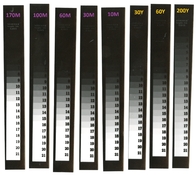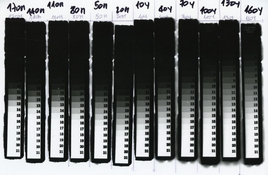Hello,
For the first time I have an enlarger of my own that I have bough used: an LPL7700 (previously I was printing at a shared darkroom to which I don't have access anymore, so unfortunately I cannot compare with other enlargers).
To get a feeling of the range of contrasts available to me, I have made a series of 8 contact prints from a step wedge (Stouffer T2115), from 200Y all the way to 170M.
Honestly I have thrown in the "extremes" just of curiosity, expecting to see most of the differences in contrast around the "central settings" of Y and M, going by the "contrast grades" of the paper manufacturer suggesting to start around 60Y and end at 130M (there are no specific settings for the LPL so I am extrapolating a bit from other enlarger brands such as Durst and Meopta).
If you see the scan below, nothing much changes around the central settings (60M to 30Y looking largely the same?).
Just curious if this "unexpected" (something wrong with the enlarger head)?
My next step would be to create more steps in the gaps between 170M and 100M, and 60Y and 200Y respectively because that's where, it seems, the real difference exists.
Paper is Fomaspeed Variant RC (I repeated the same experiment with Fomabrom Fiber Base and the results are virtually identical). Paper is around 2 years old.
All steps have the same exposure (32' at f4) and identical development (they were all exposed in series, kept in a black paper envelope when waiting and then all dropped in the developer at the same time. I have tried to minimize the difference in the developer when moving them over to the stop bath 2/3 at a time).

For the first time I have an enlarger of my own that I have bough used: an LPL7700 (previously I was printing at a shared darkroom to which I don't have access anymore, so unfortunately I cannot compare with other enlargers).
To get a feeling of the range of contrasts available to me, I have made a series of 8 contact prints from a step wedge (Stouffer T2115), from 200Y all the way to 170M.
Honestly I have thrown in the "extremes" just of curiosity, expecting to see most of the differences in contrast around the "central settings" of Y and M, going by the "contrast grades" of the paper manufacturer suggesting to start around 60Y and end at 130M (there are no specific settings for the LPL so I am extrapolating a bit from other enlarger brands such as Durst and Meopta).
If you see the scan below, nothing much changes around the central settings (60M to 30Y looking largely the same?).
Just curious if this "unexpected" (something wrong with the enlarger head)?
My next step would be to create more steps in the gaps between 170M and 100M, and 60Y and 200Y respectively because that's where, it seems, the real difference exists.
Paper is Fomaspeed Variant RC (I repeated the same experiment with Fomabrom Fiber Base and the results are virtually identical). Paper is around 2 years old.
All steps have the same exposure (32' at f4) and identical development (they were all exposed in series, kept in a black paper envelope when waiting and then all dropped in the developer at the same time. I have tried to minimize the difference in the developer when moving them over to the stop bath 2/3 at a time).




